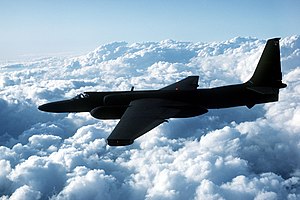
Back حادثة طائرة التجسس الأمريكية يو-2 Arabic ১৯৬০-এর ইউ-২ ঘটনা Bengali/Bangla Incident de l'U-2 (1960) Catalan Aféra U-2 Czech Κατάρριψη του U2 από τους Σοβιετικούς Greek Incidento de U-2 Esperanto Incidente del U-2 Spanish U-2 vahejuhtum Estonian U-2ren istripua Basque سرنگونی یو-۲ در سال ۱۹۶۰ Persian
This article's tone or style may not reflect the encyclopedic tone used on Wikipedia. (December 2023) |
| 1960 U-2 incident | |
|---|---|
| Part of the Cold War | |
 A Lockheed U-2 similar to the one involved in the incident | |
| Type | Aircraft shootdown |
| Location | 56°43′35″N 60°59′10″E / 56.72639°N 60.98611°E |
| Objective | Intercept American U-2 reconnaissance aircraft |
| Date | 1 May 1960 |
| Executed by | Soviet Air Defense Forces |
| Outcome | American aircraft shot down, pilot Francis Gary Powers captured |
| Casualties | 1; Soviet pilot Sergei Safronov (friendly fire) |

On 1 May 1960, a United States U-2 spy plane was shot down by the Soviet Air Defence Forces while conducting photographic aerial reconnaissance deep inside Soviet territory. Flown by American pilot Francis Gary Powers, the aircraft had taken off from Peshawar, Pakistan, and crashed near Sverdlovsk (present-day Yekaterinburg), after being hit by a surface-to-air missile. Powers parachuted to the ground and was captured.
Initially, American authorities acknowledged the incident as the loss of a civilian weather research aircraft operated by NASA, but were forced to admit the mission's true purpose a few days later after the Soviet government produced the captured pilot and parts of the U-2's surveillance equipment, including photographs of Soviet military bases.
The incident occurred during the tenures of American president Dwight D. Eisenhower and Soviet leader Nikita Khrushchev, around two weeks before the scheduled opening of an east–west summit in Paris, France. Khrushchev and Eisenhower had met face-to-face at Camp David in Maryland in September 1959, and the seeming thaw in U.S.-Soviet relations had raised hopes globally for a peaceful resolution to the Cold War. The U-2 incident shattered the amiable "Spirit of Camp David" that had prevailed for eight months, prompting the cancellation of the summit in Paris and embarrassing the U.S. on the international stage. The Pakistani government issued a formal apology to the Soviet Union for its role in the mission.
Following his capture, Powers was convicted of espionage and sentenced to three years of imprisonment plus seven years of hard labour; he was released two years later, in February 1962, in a prisoner exchange for Soviet intelligence officer Rudolf Abel.
- ^ Samoylov, Boris (1 February 2012). "Загадка первомая 1960 года – часть I" [Riddle of May Day 1960 – Part I]. Военно-промышленный курьер (Military-Industrial Courier, VPK) (in Russian). Archived from the original on 25 July 2020. Retrieved 21 May 2013.
© MMXXIII Rich X Search. We shall prevail. All rights reserved. Rich X Search